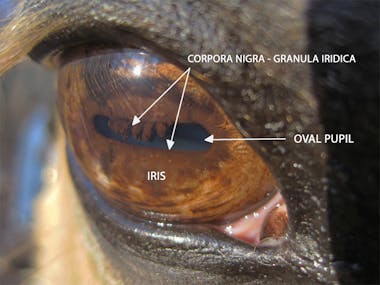horses Eye info...

Horses have unique and fascinating eyes that play a crucial role in their survival and behaviour. Here's some information about a horse's eyes...
Placement and Vision...
Horses have eyes on the sides of their heads, providing them with almost 360-degree vision. This placement allows them to have a wide field of view, making it easier for them to detect potential threats from predators in their surroundings. However, due to their position, they have a blind spot directly in front of and behind them, where they cannot see.
What is binocular Vision?
While horses have an excellent peripheral vision, their binocular vision is limited. Binocular vision is the ability to focus both eyes on the same object simultaneously, providing depth perception. Horses can see some objects with both eyes, but they primarily use one eye at a time when looking at something up close.
what is monocular Vision?
Horses rely heavily on monocular vision, meaning they use each eye independently. This feature allows them to keep a constant lookout for predators while grazing or moving. It also enables them to see different things with each eye, enhancing their ability to detect movement and changes in their environment.
did you know horses have Night Vision?
Horses have remarkable night vision due to a special reflective layer behind their retinas called the tapetum lucidum. This layer reflects light back through the retina, maximising the amount of available light for better vision in low-light conditions. This adaptation is beneficial for their natural behavior as prey animals, as it helps them detect potential dangers in dimly lit environments.
Colour Vision...
Horses have dichromatic vision, meaning they can see two primary colours: blue and green. They lack the red and yellow colour receptors found in humans, which means they cannot distinguish between these colours well. Horses are generally considered to be colourblind to some extent, but they can still differentiate various shades of blue and green.
Blinking and Tear Production...
Horses have a third eyelid, known as the nictitating membrane or "haw." This membrane moves horizontally across the eye to protect and moisten it, especially during dusty or windy conditions. Horses blink less frequently than humans, which helps protect their eyes from dust and debris.
horses Eye Health...
Maintaining good eye health is essential for a horse's overall well-being. Eye injuries and infections can occur, especially in horses that spend time in dusty or sandy environments. Regular eye checks by a veterinarian and keeping the horse's living area clean and free from potential hazards can help prevent eye issues.
Understanding a horse's unique visual capabilities and the importance of eye health is vital for responsible horse ownership. If you notice any signs of eye discomfort, discharge, or changes in the appearance of the eyes, it's essential to seek veterinary attention promptly to address any potential problems.






